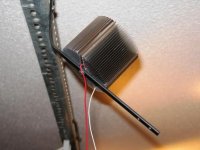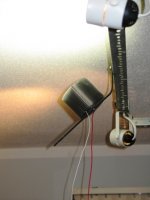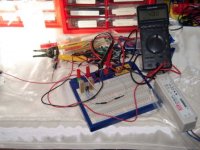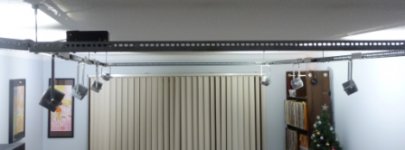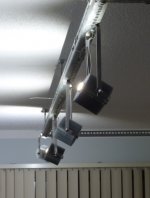Well, I was talking about Philips and Osram CFLs (€ 5-6), not the cheap no name CFLs. Sure Philips and Osram also manufacture most of them in China, but quality control is good.
Because I maintain the lobby/stairwell-lighting in our apartment building, I get to change many more CFLs than the average household. Since I started I must have replaced at least 20-30 CFLs and among them there was only one early failure and one dud (for the latter I got a replacement). In that kind of usage (on at dusk, off at dawn) they last 2-3 years and exceed the specified lifetime considerably (I wrote the install date on the base of a few). One lasted about 15,000 hours before failing - it was specced at 6,000 hours.
In household circumstances (normal service), the frequent on-off switching is a real problem for most cheap CFLs (quite a bit of the emission-mix gets knocked off the electrodes during ignition, esp. with the cheaper non-preheat type).
In the EU, it´s now mandatory that not only the average lifetime in hours is specified on the package, but also the average number of cycles.
Dirt cheap CFLs only have about 3,000 cycles. Switch it on and off 10 times a day, and it might not even last a year. The better brands start at 5,000-10,000 for instant start lamps and that goes up to 20,000-50,000 for preheat start types. Specialist types may even achieve 500,000-unlimited number of cycles.
Choose the right one, and you will save quite a bit of money.
In that respect I find 20,000 cycles for a LED bulb very meagre, but perhaps Philips is playing it safe until there's enough hard data to base that figure on.
Because I maintain the lobby/stairwell-lighting in our apartment building, I get to change many more CFLs than the average household. Since I started I must have replaced at least 20-30 CFLs and among them there was only one early failure and one dud (for the latter I got a replacement). In that kind of usage (on at dusk, off at dawn) they last 2-3 years and exceed the specified lifetime considerably (I wrote the install date on the base of a few). One lasted about 15,000 hours before failing - it was specced at 6,000 hours.
In household circumstances (normal service), the frequent on-off switching is a real problem for most cheap CFLs (quite a bit of the emission-mix gets knocked off the electrodes during ignition, esp. with the cheaper non-preheat type).
In the EU, it´s now mandatory that not only the average lifetime in hours is specified on the package, but also the average number of cycles.
Dirt cheap CFLs only have about 3,000 cycles. Switch it on and off 10 times a day, and it might not even last a year. The better brands start at 5,000-10,000 for instant start lamps and that goes up to 20,000-50,000 for preheat start types. Specialist types may even achieve 500,000-unlimited number of cycles.
Choose the right one, and you will save quite a bit of money.
In that respect I find 20,000 cycles for a LED bulb very meagre, but perhaps Philips is playing it safe until there's enough hard data to base that figure on.
Last edited:
You can buy LEDs on stars quite cheaply from eBay.
MR11 and MR16 LED lamps are also pretty cheap, about $4 and up (including shipping).
As for drivers, adding one resistor to a typical car cellphone charger will create a constant-current driver. I've opened up a half-dozen of those and they all contained some version of the MC34063 switching regulator. (As did a camcorder charger, and a $2 USB lighter jack) This isn't the most efficient driver, though, because the chip uses a 1.25V reference voltage. Google for the ON Semiconductor app note ONS_MC34063A_AN1.pdf.
A more efficient switching driver chip is the PT4115; you can get drivers with that chip from Dealextreme.
If you want to be able to dim your LEDs, it's best to use PWM control. LED colour can change if you just lower the current, so switching it on and off at a constant current makes it dimmer without altering colour. The ATTiny13 is commonly used in flashlight drivers, and various people have come up with custom firmware for it. If older PICs are your thing, there's the freeware lightbrain dimmer that was originally designed for incandescent bike lights, but should be adaptable to LEDs. And the source code is there.
PWM is also the "correct" way to regulate a Peltier cooler (or TEC: thermo-Electric Cooler); here's one that looked easy to adapt to LED control using a common chip:
W's simple high power PWM TEC controller You should be able to find a similar chip in an old PC power supply, and maybe a power MOSFET to use as well.
Using a resistor as a driver isn't an awful idea. With a correctly sized resistor, reliability should be much higher than any active driver. And with a bunch of LEDs in series efficiency may be as good as with a switching driver.
You should find some advice on fish tank forums; I know I've run across some while googling for LED information.
Thanks for the response. I'm looking at the CREE XM-L T6 line and the power requirements are... more than I thought. Must do more research
I want to revive this thread.
The quality of the halogen bulbs is getting progressively worse in US . I am considering the alternatives.
. I am considering the alternatives.
Got myself Cree CX2011 from Mouser and aluminum Heatsink from Ebay (China) for experimenting. I mounted the prototype close to the ceiling and powered up (see photos). So far, so good. Running the LED at 0.43A @ 44V (19W). The heatsink is at about 55C, just perfect.
It is difficult to compare the brightness of the LED to that of the halogen 12V bulb because the radiation angles are different (120 for LED vs. 50 for flood 12V bulb). Subjectively, they are comparable.
I will post a progress report if I decide to go ahead with a project.
The quality of the halogen bulbs is getting progressively worse in US
Got myself Cree CX2011 from Mouser and aluminum Heatsink from Ebay (China) for experimenting. I mounted the prototype close to the ceiling and powered up (see photos). So far, so good. Running the LED at 0.43A @ 44V (19W). The heatsink is at about 55C, just perfect.
It is difficult to compare the brightness of the LED to that of the halogen 12V bulb because the radiation angles are different (120 for LED vs. 50 for flood 12V bulb). Subjectively, they are comparable.
I will post a progress report if I decide to go ahead with a project.
Attachments
Update:
Ordered MV LPV-60-48 switching power supply from Jameco (48V, 1.2A). Connected CX2011 to the power through the current source. I used LM317 voltage regulator configured as a current source (sampling Resistor R=3.0 ohm). The setup is working perfectly. I guess this is the best way to go. LP-PV-60-48 can be used to feed two LEDs and each led will have its own current source. LM317 needs small heat sink (4.7V is dropped on the CS at about 0.4A current).
Now the cost:
If you are doing 10 LEDs
Heatsink $20 each $200 total
LED $19 each $190 Total
PS $21 each $105 total
$495 total Expensive
Ordered MV LPV-60-48 switching power supply from Jameco (48V, 1.2A). Connected CX2011 to the power through the current source. I used LM317 voltage regulator configured as a current source (sampling Resistor R=3.0 ohm). The setup is working perfectly. I guess this is the best way to go. LP-PV-60-48 can be used to feed two LEDs and each led will have its own current source. LM317 needs small heat sink (4.7V is dropped on the CS at about 0.4A current).
Now the cost:
If you are doing 10 LEDs
Heatsink $20 each $200 total
LED $19 each $190 Total
PS $21 each $105 total
$495 total Expensive
Attachments
Last edited:
hi guys.
I found this LEd array check the psecs on this it looks verry promissing for a LED mod in a projector
http://en.honglitronic.com/Upload/goods/2013/09/26/20130926122346zcwm.pdf
I found this LEd array check the psecs on this it looks verry promissing for a LED mod in a projector
http://en.honglitronic.com/Upload/goods/2013/09/26/20130926122346zcwm.pdf
Hi All,
Finally I completed the project and want to share some details. I ended up with 7 CXA1512 (newer, brighter and cheaper!) and one CXA2011 (because I already had it). For 8 LED lights I used 4 LPV-60-48 power supplies. One power supply per 2 LEDs.
Room is super brightly lit even though all the light is reflected from the ceiling and walls.
Overall I am very happy and hope that these lights will last quite some time. On the negative side, the cost of the project is quite high.
Finally I completed the project and want to share some details. I ended up with 7 CXA1512 (newer, brighter and cheaper!) and one CXA2011 (because I already had it). For 8 LED lights I used 4 LPV-60-48 power supplies. One power supply per 2 LEDs.
Room is super brightly lit even though all the light is reflected from the ceiling and walls.
Overall I am very happy and hope that these lights will last quite some time. On the negative side, the cost of the project is quite high.
Attachments
what is the main "ingredient" of the typical LED used in residential/commercial lighting? Is this something that the planet has in large quantities or will we be hearing stories in 50 years of LEDs being abandoned in favor of fireflies?
"Rare earths"
(below) worse than OPEC
New mine in BC , canada , S. america (bolivia- owned by chinese).
NO ONE mentions Afghanistan .... they could have more than the Chinese.
One wonders why everyone likes Afghanistan (really ,really, LIKE it ! $$$)
OLED's still use a little Indium ... but MUCH less than todays LED's.
They actually did study fireflies as OLED's are similar !
OS
OS
Attachments
hi new to site.Tony is my name. Im attempting to make my truck stereo install look real impressive want to make some kind of Plexiglas enclosure for amp.will have fans to cool.want to have lighting {led} .I have 35 leds that change color red,green,blue ish.they have 4 pins one ground 3 for 1 each color .will probably put in a board .about wiring?I know phone wire has 4 wires in line and would make for easy connect and disconnect .and should handle power need.but to wire parallel or series and resistor needed.how many leds are 12 volt dc.also design anp is about 20 x 11 with brand on top middle.thinking maybe only top of bot plexy or maybe colored except above name.any help is appreciated thanks Tony
hi new to site.Tony is my name. Im attempting to make my truck stereo install look real impressive want to make some kind of Plexiglas enclosure for amp.will have fans to cool.want to have lighting {led} .I have 35 leds that change color red,green,blue ish.they have 4 pins one ground 3 for 1 each color .will probably put in a board .about wiring?I know phone wire has 4 wires in line and would make for easy connect and disconnect .and should handle power need.but to wire parallel or series and resistor needed.how many leds are 12 volt dc.also design anp is about 20 x 11 with brand on top middle.thinking maybe only top of bot plexy or maybe colored except above name.any help is appreciated thanks Tony
There is no standard value for forward voltages. There are rough ballpark values but the fact of the matter is, you NEED to know your standard voltage or the LEDs will die a quick death. Without that value there isn't much we can do to help you.
LEDs normally have a currant rating and need a resistor like a neon bulb but at a much lower voltage.
They live a short life if the currant is too high.
You need a data sheet for the parts you are using and a calculator.
They are between 1.8 volts and 2.4 volts at about 10ma.
Try them in 5s on 12 volts with a 120 ohm resistor to limit the currant and they are polarity sensitive too.
They live a short life if the currant is too high.
You need a data sheet for the parts you are using and a calculator.
They are between 1.8 volts and 2.4 volts at about 10ma.
Try them in 5s on 12 volts with a 120 ohm resistor to limit the currant and they are polarity sensitive too.
Thank you ,since I dont have package they came in Ill have to investigate .My brother gave to me about 30 or so.Ill ask him,or see if the same ones are at electronic shop near me . Im in there a lot bugging them. lol. And Ill experiment also. Ive played a bit with a 9 v battery to see colors they produce .When Im sure of the forward voltage Ill post.Mean while still trying to design a Plexiglas enclosure for my new amp.That and also making [trying] a thing on ceiling .Like in a limo or a conversion van.With smoked covering and led behind. found one in junkyard and easy to make but I want it more .[cooler]And plex box has me kind of stumped on design ideas.Hey,Thanks again Tony.
- Status
- This old topic is closed. If you want to reopen this topic, contact a moderator using the "Report Post" button.
- Home
- General Interest
- Everything Else
- LED lighting - what's with the huge heatsinks?
